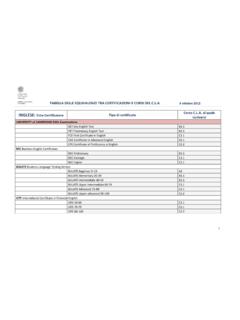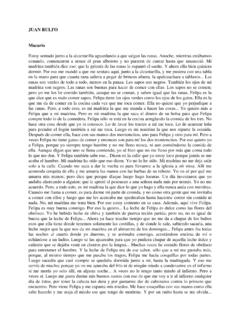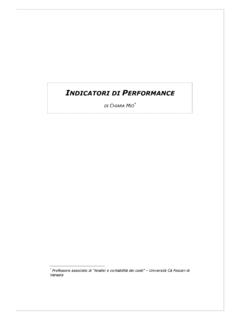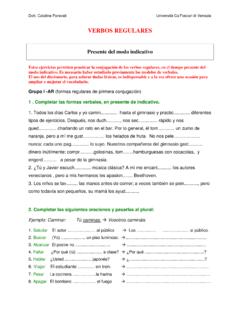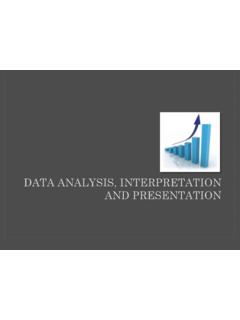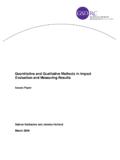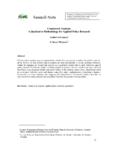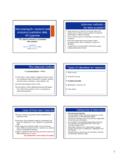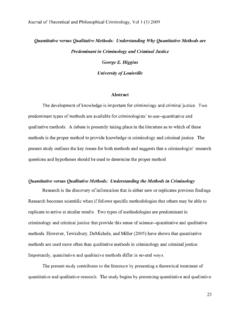Transcription of Content Analysis: Objective, Systematic, and …
1 Content analysis : Objective, Systematic, and quantitative Description of ContentRoberto FranzosiBy the time of the publication of the first general textbook in contentanalysis in 1952 (Berelson s Content analysis in CommunicationResearch), the basic ingredients of the new methodology had allbeen worked out. And so had the rhetorical format of introducing thetechnique through a list of definitions by various authors we will findthat same format in later textbooks from Holsti to Krippendorff, and invarious accounts of the development of Content analysis from Shapiroand Markoff to to this format, the following early defin-itions2leave no doubt about the quantitative nature of the technique: [the method of] quantitativecontent analysis .. consists of tabu-lating the occurrences of Content units .. Content analysis .. attempts to characterize the meanings in agiven body of discourse in a systematicand analysis is the statisticalsemantics of political discourse.
2 Content analysis aims at statisticalformulations, directed towardempirical problems .. its statistical character [is] one of its mostdistinctive attributes. A distinguishing characteristic of Content analysis .. is its quan-titativeaspect. Indeed, Content analysis was born as a quantitative technique. Harold , Lerner, and de Sola Pool (1952: 45; emphasis added), the fatherfounders of the technique, put it in these words: There is clearly no reasonfor Content analysis unless the question one wants answered is quantitative . 3 Quantification was the result of frequencies obtained through his statement of the state of the art of Content analysis , by 1959standards, de Sola Pool (1959: 195) wrote: Counting frequencies was themain activity of Content analysts in the 1930s and 1940s. Indeed, for manypeople that is how Content analysis was defined.
3 Berelson s book minusone chapter is almost wholly devoted to such frequency counts. Harold s Content analyses were frequency counts of symbols .. 11/14/07 12:49 PM Page xxixxiiINTRODUCTION why be quantitative ? That question provides the title to an introductorychapter in Lasswell et al. s Language of Politics. Studies in QuantitativeSemantics(and with which this collection opens). In addressing the question,Harold D. Lasswell makes clear his position in a choice between handlinghistorical and social problems with more exact methods and with pre-cision versus the alternative of a purely qualitative, impressionisticandconjectural approach (Lasswell, 1949: 47; emphasis added). By the timehe opens his concluding paragraph with the summary question Why,then, be quantitative about communication? the reader has little doubtabout Harold D.
4 Lasswell s answer (1949: 52): Because of the scientificand policy gains that can come of it. Yet, while quantification is certainly a defining feature of contentanalysis, it was hardly the only (or perhaps even the main) one. A system-aticand objectiveapproach to measurement issues was no doubt just asimportant. In one of the earliest documents on Content analysis , Waplesand Berelson (1941: 2) wrote: Systematiccontent analysis attempts to definemore casual descriptions of the Content , so as to show objectivelythe natureand relative strength of the stimuli applied to the reader or listener. Harold D. Lasswell himself insisted that (1942: 15; emphasis added):Impressionisticor systematic procedures may be used in describingcommunication Content . When impressionismprevails, individualscharacterize Content without specifying the criteria that they use inmaking up their minds.
5 They take no special precautions to checktheir judgments against those of other trained people in order toreduce the effect of whim and caprice. When systematicproceduresare used the criteria of judgment are made as explicit as anathema against impressionism would be picked up by others,close to Harold D. Lasswell. Kaplan compares Content analysis to an impressionistic method of inquiry. Janis and Fadner write: Impressionisticjudgments suffice for broad classification of symbol data and descriptionof gross temporal changes in the Content of mass communications.. Butif we wish to develop precise hypothesesconcerning mass communications,there is a need for quantitative analysis of symbols. Leites and de Sola Pool contrast the objectivity of Content analysis with other more subjective or impressionistic ways of talking about symbols.
6 6 Not surprisingly,Berelson, in his textbook, would define Content analysis as: a researchtechnique for the objective, systematic, and quantitativedescription of themanifest Content of communication. Quantification, in this view, goes hand in hand with systematization,rigor, precision, and exactitude in definitions and measurements, withobjectivity and replication of procedures and findings, in other words, 11/14/07 12:49 PM Page xxiiINTRODUCTION xxiiiwith a scientific approach to social science. And the goal of that scientificapproach to which Content analysis is seen as an important meth-odological contributor is to rigorously test hypotheses drawn frombroader theoretical frameworks. Content analysis marks the most prom-ising direction along which the sciences of signs might proceed to formu-late and substantiate precise empirical.
7 7 Hypothesis testingfeatures prominently in Leites and de Sola Pool s programmatic docu-ment On Content analysis (1942: 21; emphasis added):Four major functions of Content analysis may be distinguished:a. to produce increases in the degree of confirmation of hypothesesalreadygenerally presumed to be valid and definitive disconfirmation of hypoth-esesalready generally presumed to be To correct optical illusions which may be shared by most To settle disagreements among specialists as the truth value of To permit (1) the formulation and (2) the testing of , the great potentiality of Content analysis lies in hypothesis test-ing carried out in a systematic and scientific way ( Janis, 1943: 429 430).And that potentiality is in addition to the general advantage that isafforded by quantitative results, namely, the applicability of the prob-ability calculus by use of inductive statisticaltests of significance.
8 If for noother reason than this, Content analysis is an invaluable scientific tool for thestudy of symbolic behavior ( Janis, 1943: 430; emphasis added).The overall aim of such a research program, as expressed by HaroldD. Lasswell and his associates, was anything but trivially concerned withpicky methodological questions. No. The aim was much farther reaching,as Harold D. Lasswell himself put it in one of the early documents (1941: 1, 12; emphasis added): The technique of symbol analysis , prop-erly applied, can provide us with insight into the lives of others by show-ing us what has come to their attention.. By means of symbol analysis [ Content analysis ] it is clear we are able to arrive at rather unambiguousdescriptions of fundamental features of society. Where did the Label Content analysis Come from?Writing in September 1942 (p. 1; emphasis added), Leites and de SolaPool state: During the last few yearsthe term Content analysis has beenincreasingly used by students of symbolic aspects of society, particularlyin connection with the studies and suggestions of Harold D.
9 Lasswell. InNovember of that same year, Janis and Fadner (1942: 2; emphasis added)similarly write: In recent yearsa number of studies .. have 11/14/07 12:49 PM Page xxiiiquantitative Content analysis . A year later, Kaplan (1943: 230; firstemphasis added) writes: In recent yearsthere has been (and is being) devel-oped, especially by Harold D. Lasswell and his associates, a techniqueknown as Content analysis . It appears from these citations that by the end of 1942, the label con-tent analysis had already been in use for at least a few years. It alsoappears that Harold D. Lasswell was a key figure in this , the term Content appears in many titles, even a few decadesearlier than 1942 (in such expressions as Content of newspapers, contentof radio programs, editorial Content , mass media Content , Content of masscommunications, or communication Content ).
10 9 But the label contentanalysis does not appear in writing until that year, Waples,11 Berelson, and Bradshaw use the label in theirbook What Reading Does to People(1940).12A year later, in April 1941,Waples and Berelson use the label in the title of a typed document: What the Voters Were Told (An Essay in Content analysis ). Harold himself, however, despite the wide acknowledgments for hisrole in the development of the label, shows some ambiguity in his choiceof April 1941, he does use the label Content analysis in thetitle of one of the internal documents of the Experimental Division for theStudy of War Time Communications,14 The Technique of Symbol analysis ( Content analysis ), but in parenthesis and alongside another main label, symbol analysis . Still in 1949, in one of the first edited books that col-lected the early methodological and substantive contributions of the newtechnique of Content analysis , Harold D.


